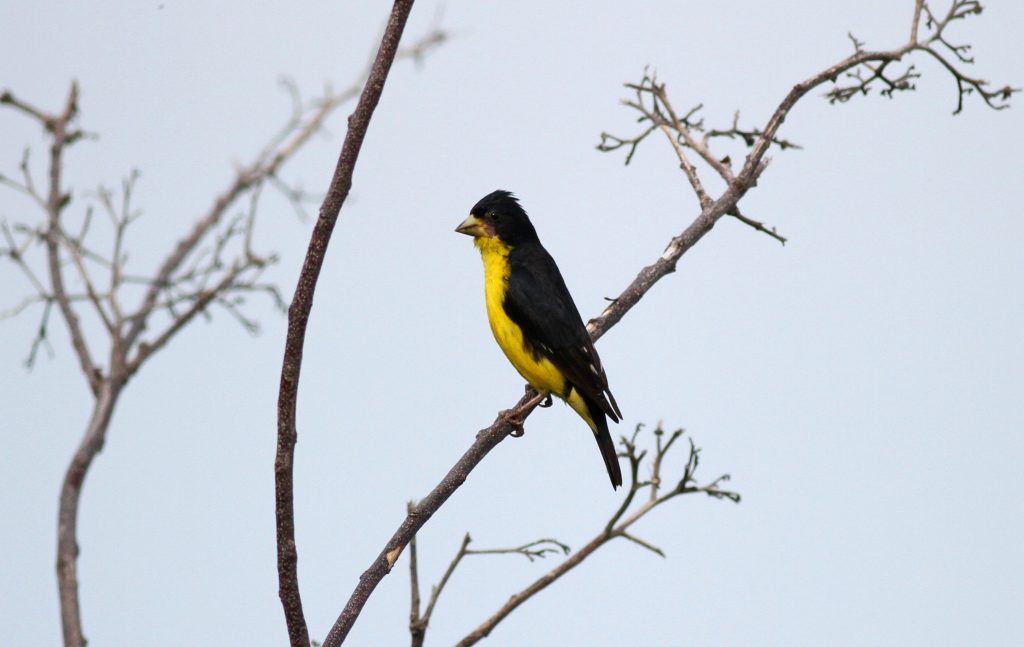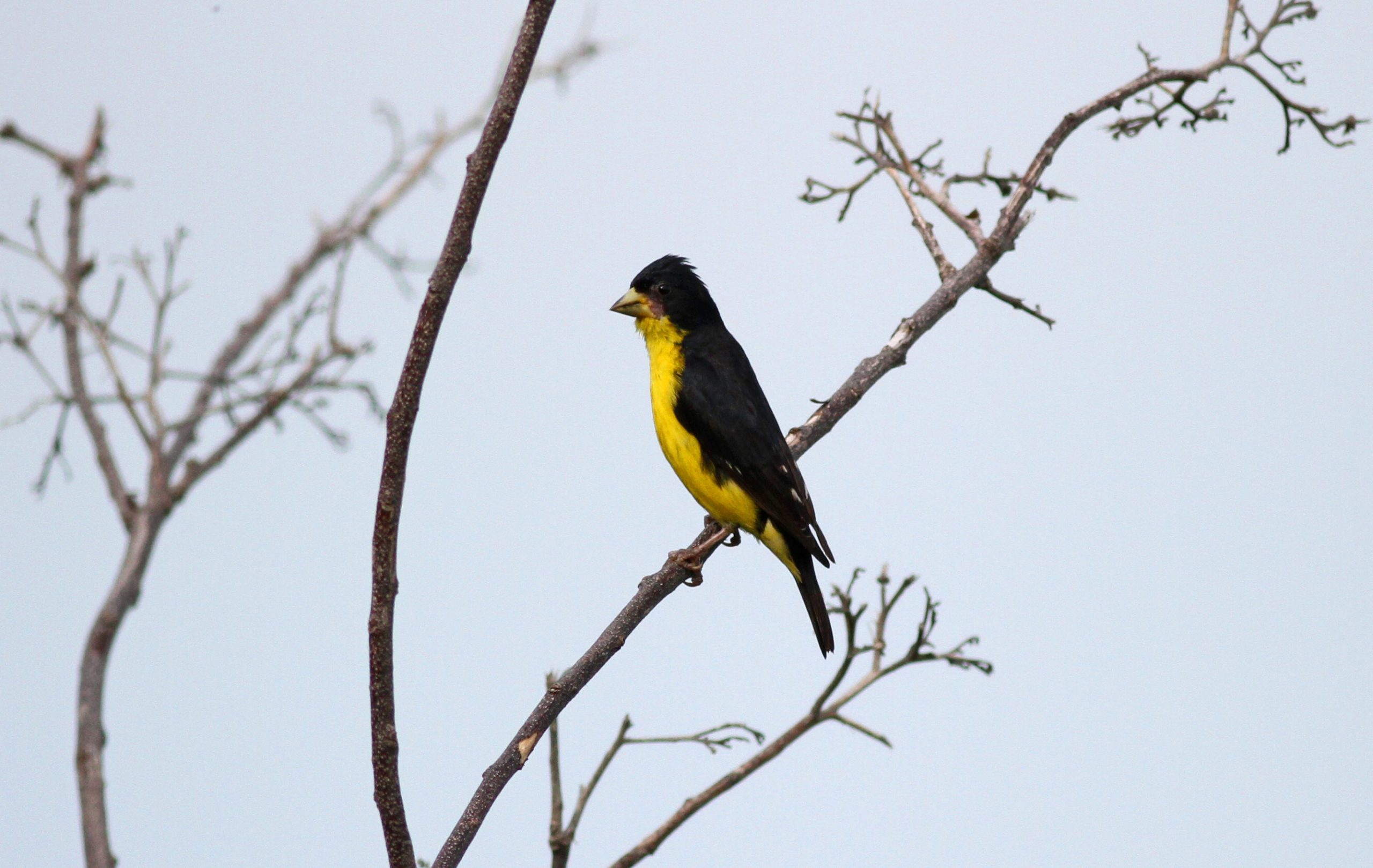Cover Photo of a Black-backed Goldfinch
Author Sean Cozart: Populations of the Lesser Goldfinch, with new discussion about subspecies
Birders across the western portion of the continent often view one of the smallest birds in North America on their thistle socks. You often recognize them by their small size, aggressive behavior at feeders, chittery feeding calls and white wing patches. Wherever you are, you tend to enjoy the company of Lesser Goldfinches.

However, the taxonomy of the species is far from resolved. Though Birds of the World and partner organizations recognize at least five subspecies of Lesser Goldfinch, the status of these subpopulations have been debated for the past century for various reasons. These goldfinches can be separated easily into two field identifiable groups; the Green-backed Goldfinch (ssp hesperophilus) of western US and the Black-backed Goldfinch from southern US to Colombia. Females are considered unidentifiable.
The status of the Green-backed Goldfinch has been debated since it’s description in 1903. Many explanations have been provided, explaining why these olive-backed males occur from immature plumage, non-breeding males, polymorphism or ecological adaptation, yet subspecies was usually the last to be considered.
If we are to accept the existence of the Green-backed Goldfinch as a subspecies, we also run into a complicated nomenclature issue. The first Lesser Goldfinch specimen was collected by Thomas Say along the Arkansas River near what is now Colorado Springs in 1823. Though by range, this is well into Black-backed territory, Harry Oberhosler (1903) described the type specimen as being an “immature green-backed specimens which are indistinguishable from individuals of the constantly green-backed form found in California; but notwithstanding this, the name must be used for the black-backed Colorado bird.” Though I have not seen the specimen myself, this specimen sounds suspiciously like a typical Green-backed Goldfinch. If it is a true Green-backed, then the nominate subspecies (psaltria) name should be applied to this population. This would require the Black-backed Goldfinch to be renamed, and in which case the synonym mexanicus, dubbed by William John Swainson in 1827, would receive priority.
In 2009, Ernest Willoughby created the Lesser Goldfinch “scoring system” to identify the plumage variation of the species, with 0 being females and 9 being males with completely blue/black upperparts. He used this system to rank over 1000 museum specimens, with his consensus being that species had too much clinal variation to truly represent subspecies.
Despite the limited recognition of Lesser Goldfinch subspecies, I believe there’s plenty of evidence suggesting this to not be the case. The one thing Willoughby’s research lacked was the presence of field work on the species, and acknowledgement of seasonal changes. I reviewed photos of 30 male Lesser Goldfinches in each US state they breed in through the phenomenal contribution of citizen science on the Macaulay Library. Using Willoughby’s scoring system, let’s assume all 1-3 are Green-backed Goldfinches, 7-9 Black-backed Goldfinches, 4 and 6 as putative intergrades, and 5 as solid intergrades.
After reviewing these 360 males, I found something particularly interesting. It seems that “pure” Black-backed Goldfinches are quite rare in the US and the only state that primarily has Black-backed Goldfinches is Texas. If proportions stay true to the population as a whole, this suggests only 15% of all US Lesser Goldfinches are Black-backed. Even states listed in field guides as Black-backed territory are roughly half and half with several mountain ranges seemingly separating these two populations. Additionally, only 4 solid intergrades (score 5) have been photographed and proportions stay the same with all Lesser Goldfinches, they make up only 1% of the entire population. Assuming individuals scoring 4 and 6 are also intergrades, then only 6% of the population are crossed between the two populations. Predictably, these intermediate variations were photographed primarily in Arizona, New Mexico and Texas.
For experience reasons, I also scored over 50 Green-backed males in Washington/Oregon through my personal photos and sightings. Nearly all of these males were a score 2 by Willoughby’s standards, having a blue/black cap extending nearly to the nape but the nape and back is unmarked olive. Score 1 was the next common phenotype having a blue/black cap that ends at the eye and often flecked with green. Lastly, only a handful of individuals score a 3 with having green-fuscous streaking on the back, however this feature is only visible when exceptionally close to the subject. Regardless, the variation exhibited by my individuals suggests nothing more than normal Green-backed Goldfinches.
Some facts that Willoughby did not acknowledge with Lesser Goldfinch is the difference in breeding, molting and migratory patterns. The reason the intergradation levels are so low in places of range overlap is because by the time Black-backed Goldfinches (nests July-October) start laying eggs, most Green-backed Goldfinches (nests April-July) are a week away from fledgling. With such a narrow window of time for an individual of each population to pair up, intergradation is surprisingly low. To make the window tighter, Phillips (1964) and Rosenburg (1991) concluded that the species in general does not raise a second brood unless the first brood fails early in the season.
Because of the differences in breeding patterns, the molt patterns of the two subspecies differ as well and their semi-annual molts occur before breeding (partial molt) and during the fledgling period of their respective breeding seasons. As a final difference between the two populations, the Green-backed Goldfinch tends to be non-migratory and does not prepare for long distance travel in the fall unlike the Black-backed who migrates to Texas or Mexico.
The reason why I’ve listed score 4 and 6 as putative intergrades is because there might be a reasonable explanation of these phenotypes. Referring back to my backyard Lesser Goldfinches, the only time I visually saw a score 1 male was between the months of November and April. They would have a restricted blue/black cap, but the blue/black feathers are edged in olive, creating a flaked look. This phenotype is coincidentally between their semi-annual molts, suggesting these male are of the following: one, a non-breeding plumage or two, an unrecognized plumage between juvenile and adult. There is also the possibility that like starlings where they wear off their spots by summer, these goldfinches might be the same “plumage” but the green is gradually worn off by summer instead of molted. Any of these possibilities could very well be the explanation for “intergrades” seen in the southwest, as these individuals are pretty much Black-backed with extensive green flaking to the head and upperparts.
With all of this information presented, this brings an even bigger question to the table. While some still deny the existence of these subspecies, the obvious differences in male plumages, ecology, migratory patterns, molt patterns and low percentage of interbreeding is enough to play the speciation card. At this point of time, there’s not enough information to confirm this hypothesis as fact and some things need to be resolved, like identification of females, and the stability and health of confirmed intergrades and their interactions with pure individuals. Genetic studies would also be helpful as sampling that has occurred in the species has been small and was used only to confirm that the Lesser Goldfinch is the “missing link” between goldfinches and euphonias. Because of this, the Lesser Goldfinch populations to my eyes resemble the Green-winged/Common Teal conundrum.
I hope as a direct result of this article, eBird will add the Green-backed and Black-backed Goldfinches as Identifiable Sub-specific Forms (ISSFs) to their taxonomy to allow their contributors to more precisely identify their Lesser Goldfinch. Giving citizen scientists this opportunity will greatly increase our understanding of the distributions of these populations and their interactions between each other.
Many will have their opinions and several contrary to mine but as I sit on my front porch on this warm late May day, watching a mother Green-backed Goldfinch feed three fledglings… one thing that is for certain……..even with our common backyard species, there’s still much to learn.
Cover Photo Credit of a Black-backed Goldfinch Jay McGowan. Posted again here for comparisons:

FiRN is a nonprofit, and has been granted 501c3 status. FiRN is committed to researching and protecting these birds and other threatened finch species like the Evening Grosbeak and Rosy-finches, and if you have been enjoying all the blogs and identifying of Red Crossbill call types, redpoll subspecies and green morph Pine Siskins FiRN has helped with, please think about supporting our efforts and making a small donation at the donate link below.
Sean Cozart: Brought up by a degreeless herpetologist father and a stay-at-home photographer mother, I was exposed to the nature beauty of the world at a young age. When raised near one of the greatest ecosystems in the world, Yellowstone, only fed my curiosity. My sister introduced me to the very healthy obsession of birding when I was 10 and I’ve been hooked since, trying to see and photograph everything I see. Nine years later, I’m pursing a career in wildlife biology specifically trying to study raptors and promoting the revival of subspecies identification.

